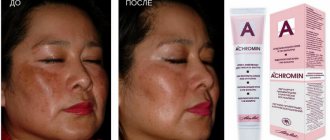What is a melanin cell in the human body: functions in skin, hair, eyes
Melanin in the human body
Melanin is a pigment that is responsible for the color of our skin, hair and iris. The dyes in this group are named after the Greek word molasses , which can be translated as dark or brown.
Melanin cells are found in humans, as well as in animals, invertebrate organisms, or even in various microorganisms. In each of the organisms mentioned, the pigments of this group perform different functions, but one thing is certain: these are substances with extremely important functions.
Soluble forms of melanin can perform a transport function, as they easily overcome even the blood-brain barrier (the barrier that protects the brain). Melanin protects the body from such pathologies and conditions:
- Malignant degeneration of cells, neutralizing the carcinogenic effects of: UV rays and ionizing radiation, reducing the accumulation of radionuclides in the body.
- Reduces the metabolic activity of chemical carcinogens.
- Under conditions of the combined action of gamma radiation and stress, it exhibits a powerful adaptogenic effect, being a very strong antioxidant.
It was revealed that eumelanin (this is a type of melanin) significantly reduces dystrophic-destructive changes in the liver, hypothalamus, thyroid gland and adrenal glands. What other types of this substance exist, read below.
Types of melanin
Humans have three different pigments belonging to the melanin group:
- Eumelanin is black-brown in color and is most abundant in the body.
- Pheomelanin is a yellowish-red pigment.
- Neuromelanin - This form of natural pigment is found in the nervous system. Produced in large quantities in catecholaminergic cells of the substantia nigra and locus coeruleus. It is produced by nerve cells, and at present its function is not fully understood.
How is this substance produced? Find the answer below. Read on.
Melanin production: synthesis
Melanin is produced in the human body by special cells called melanocytes. They are mainly present in the basal layer of the epidermis.
- The pigment produced by melanocytes is synthesized and stored in special vesicles called melanosomes.
- Over time, these bubbles are transported to higher layers of the skin.
- They eventually reach the keratinocyte region.
- There the pigment is deployed, which can now perform its protective functions.
Melanin itself is produced in a complex cycle of changes, the initial substrate of which is the amino acid tyrosine. The main enzyme involved in these transformations, known as melanogenesis, is tyrosinase.
Melanin: factors regulating its production
Melanin: factors regulating its production
Certain factors can stimulate and others inhibit the process of melanogenesis. Factors regulating the production of this substance:
- Melanin production is stimulated by ultraviolet radiation. Therefore, when we sunbathe during the summer season, our skin acquires a brownish tint (so desired by some).
- Other substances that may increase melanogenesis include alpha melanotropic hormone (alpha MSH) and adrenocorticotropin (ACTH).
- Among the factors that can interfere with the production of natural pigments are various interleukins.
Worth knowing: Vitamins A, B, as well as minerals calcium and iron, affect the process of melanin formation.
Medicines and dietary supplements
Melanin is an organic substance, the production of which can be activated and the condition of the skin can be improved through the use of various medications and dietary supplements.
The table shows some of them:
| Name of the drug | Compound | Indications for use | pharmachologic effect | Price |
| Retinol acetate (Russia) | Vitamin A oil solution. | Prevention and treatment of A-hypovitaminosis. | It has a pronounced antioxidant and immunostimulating effect, promotes tissue regeneration, improves vision, normalizes metabolism, and increases the body's resistance to infections and colds. | The price depends on the form of release and the manufacturer from 8 to 250 rubles. |
| "Pro Soleil" (France) | Lutein, beta-carotene, vitamin complex. | Recommended for improving the quality of tanning. | Increases melanin production, prevents flaking and dry skin. | 30 capsules – 2000 rub. |
| "Bevital - san" (Croatia) | Vitamins E, B1, B2, B6, brewer's yeast in an inactive state. | It is recommended to take before visiting a solarium or for skin diseases. | Prevents photo-aging of the skin. | 60 capsules – 250 rub. |
| "Nature Tan" (France) | Turmeric, selenium, grape extract, zinc, beta-carotene, vitamins E, C. soy isoflavones. | Protects against ultraviolet radiation. | Helps increase pigment production. | 30 capsules – 1219 rub. |
| "Norwesol" (Norway) | Seal fat. | Source of omega-3 polyunsaturated fatty acids, vitamins A and E. | It has a slight effect on the level of tanning, while effectively protecting the skin from burns and helping to improve its condition in case of any pathologies. | 100 capsules – 720 rub. |
There are other medications and dietary supplements that are effectively used to stimulate the production of the coloring pigment melanin. But before you start using them, you need to consult your doctor.
Melanin: where to find it?
Melanin is responsible for the fact that some of us have very light skin color, while others are extremely dark-skinned. The color of a person's skin is affected by the amount of melanin it contains. Black people have the most of it, while people with light skin have much less. Where else can you find melanin?
- So, the final color of the skin is influenced not only by the amount of dye, but also by the ratio of the amount of darker eumelanin to the much lighter pheomelanin.
- The same goes for hair. When they contain large amounts of pigment, especially eumelanin, they are dark in color. If pheomelanin predominates in a person's hair, it is possible that there will be reddish or light strands on his head.
However, melanin can also be found in other structures of the body. It has already been mentioned that one of its types is neuromelanin. It is present in the central nervous system. A similar dye can also be found:
- In the eyeball, melanin is responsible for the color of the irises. Dark irises are those that contain a lot of melanin; people with blue or green eyes have much less of this pigment.
- In the adrenal glands, melanin is present in the reticular layer of these organs.
- In the structures of the inner ear.
As you can see, this substance is very complex and necessary for the human body. What is its effect on the body of living organisms? Read on.
Cosmetic preparations
In pharmacies and online stores there is a wide selection of cosmetics containing melanin or components that promote its production.
Samples of such products are shown in the table:
| Name of the drug | Compound | Indications for use | pharmachologic effect | Price |
| Cream Vitasan (Russia) | St. John's wort, fir oil, cedar oil, string, calendula, walnut. | vitiligo; inflammation of the skin, for the treatment of wounds and trophic ulcers; getting an even and beautiful tan. | Improves skin color, reduces the appearance of white spots; has an antiseptic and wound-healing effect. | 1000-1200 rub. |
| Gel Vitilemna (Czech Republic) | Duckweed extract, propolis, amaranth. | vitiligo; psoriasis. | Gives good results in the treatment of skin diseases; helps strengthen the immune system and improve the general condition of the body. | 3000-3400 rub. |
| Gel Vitix (France) | Melon extract and hydrogenated palm oil. | Treatment of vitiligo spots. | Promotes the production of melanin pigment and prevents the development of vitiligo. | 2200-2750 rub. |
| Shampoo Tian De Master Herb;420 ml (China) | Extract of ginseng, lovage and angelica. | increased hair loss; baldness; slower hair growth. | Promotes the appearance of hair in areas of baldness; prevents early gray hair; activates metabolism; strengthens hair follicles. | 900-1100 rub. |
| Balm Antisedin “Russia” | Horsetail and nettle extract, ammonium chloride, ethyl alcohol, glycerin, sulfur. | premature gray hair; dandruff; hair loss. | Restores hair color and improves hair growth, prevents the formation of dandruff. | 126-167 rub. |
Melanin: action in the human body
Melanin: action in the human body
For many people, hair or skin color is extremely important, but influencing their color is not the main task of melanin. Action in the human body:
- This dye is intended to protect human skin.
- Unfortunately, the ultraviolet radiation that reaches the sun's rays is harmful to our cells.
- It can cause DNA damage, which in worst cases leads to tumor development.
- This is where the main function of melanin is manifested - the pigment has a protective effect against UV radiation. This is possible due to the fact that the pigment has the ability to both absorb and scatter ultraviolet radiation.
- In addition, the energy that is absorbed by melanin can be converted into another, which is much less harmful to the human body - we are talking about thermal energy. Thanks to this, it may become clear why people living near the equator have a much darker complexion than the Slavs.
In regions such as Africa, the impact of solar radiation is much greater than, for example, in Russia. For this reason, residents of the equatorial zone have much darker skin - the large amount of melanin in it is designed to protect against increased exposure to UV radiation.
Worth knowing: Melanin affects both the skin and the eyes. The dye protects the delicate structures of the eye from exposure to ultraviolet radiation.
The more melanin there is, the lower the risk that UV radiation will harm us. This explains why people with light eyes have an increased risk of developing various sun-related eye diseases.
The functions of melanin discussed above can undoubtedly be considered extremely important. But in fact, dyes from this group also have other valuable functions. They are able to bind and neutralize various heavy metals. However, these functions have not yet been sufficiently studied. But it is worth noting for sure that patients with Parkinson's disease, who may have low levels of neuromelanin in the central nervous system, may experience increased iron deposits in brain tissue.
Melanin: effects in other species
The beneficial properties of melanin can be appreciated not only by people, but also by other living organisms. For example, in birds, feathers containing large amounts of melanin are much stronger than feathers with less pigment. Melanin is also used by various fungi - called radiotrophic, they use the dye to absorb heat, which allows them to accumulate energy necessary for life processes.
Some microorganisms can also use melanin, which unfortunately does not benefit humans. In pathogenic microorganisms, melanin may be a factor in which they trick the host's immune system and thus are not eliminated. Other pathogens, thanks to melanin, may be more resistant to drugs, be they antifungal or antibacterial.
Increased, decreased melanin: diseases associated with abnormal amounts
Diseases associated with abnormal amounts of melanin
From the above, it is clear that the role of melanin is extremely important. However, there may be some health problems associated with this dye. They are the result of both an insufficient amount of this substance in the body and its excess. Diseases associated with abnormal amounts of this substance:
Reduced melanin:
- A condition in which a patient has abnormally low levels of this substance, especially in the skin or hair, is albinism. The person in this case is called an albino. Albinism can also be acquired and is usually associated with damage to the pigment-producing cells, the melanocytes.
- There is also such a thing as congenital vitiligo, which is a genetic disease and occurs as a result of enzymatic disorders of proteins involved in melanogenesis.
Increased melanin:
- Various types of skin lesions. For example, the presence of freckles on the skin is associated with the appearance of areas in which there is an increased amount of melanin.
- The spots that people call birthmarks or pigmented spots appear due to the local accumulation of increased amounts of melanin.
Skin cancer is another problem indirectly related to melanin. The most dangerous is malignant melanoma. It originates from cells that produce melanin - melanocytes.
What happens when there is a lack of pigment?
Melanin is a substance, the lack of which can exacerbate diseases associated with impaired pigment synthesis, such as albinism, vitiligo, Parkinson's disease and some others, leading to premature aging, loss of immunity, and early menopause in women.
But the greatest danger when melanin production decreases is caused by malignant skin tumors. A person, finding himself defenseless against the threat of radiation, runs the risk of contracting the most dangerous cancer - melanoma.
How to increase and restore the amount of melanin in the body: foods, tablets, vitamins
Melanin in the body
If there is a lack of melanin in your body, then you may have fair skin, hair and gray or blue eyes. Many people want to increase or restore the amount of this substance in the body, as it is very important for the body.
The lack of melanin is also difficult to compensate for, just like the lack of any other substances. To do this, you should have patience and consult with a specialist. There are several ways you can choose to replenish your supply of this substance. :
- Gentle - a healthy lifestyle and consumption of foods that can activate melanin synthesis.
- Medication – taking medications aimed at increasing melanin production.
To increase melanin levels, you should eat the following foods:
Melanin levels will increase if you eat these foods
As for pills and vitamins, it is better to take them after consulting a doctor. He will prescribe exactly the drug or dietary supplement in the form of a vitamin that your body needs.
People who want to whiten their skin, for example, get rid of freckles, usually want to reduce the amount of melanin in the body. This can be done with the help of drugs and vitamins, but with others - not the same as when increasing this substance.
Remember: You can take any medications or even vitamins only after consulting a doctor. Self-medication is dangerous to health and life.
Healthy lifestyle
It is well known that the level of melanin can vary depending on the characteristics of a person’s lifestyle.
In order not to experience a deficiency of vitamins, minerals and essential amino acids, which are the building blocks of cells, you need to eat a full and balanced diet. This is one of the main conditions for increasing melanin synthesis.
It is also very important to do what you love and live a full life - spend more time in nature, stop smoking , maintain a sleep-wake schedule, and avoid stress. Moderate physical activity, especially swimming, is beneficial.
Melanin: reviews
If you want to permanently remove age spots or freckles, then you need to reduce the amount of melanin. As mentioned above, this can be done with the help of medications. If you need to increase the level of this substance, then you should eat foods that will help you do this, and maybe take medications and vitamins. Read reviews from other people who have tried to change the amount of this substance in their body.
Nina, 56 years old
I didn’t think that because of my love for the sun throughout my life, I would later suffer from age spots. I always sunbathed a lot in the summer at the seaside, never covering my skin. As a result, age spots all over the body and on the face. It turned out that I produce a lot of melanin. Naturally, I wanted to whiten my skin. I tried different methods: I took vitamins, cleansed my skin with creams. Nothing helped, there was almost no effect. Perhaps I was prescribed the wrong drugs that I needed. I decided to try whitening my skin with retinoids. These are physiological substances that are familiar to the skin. I used products with retinoids, bought them at the pharmacy. After the first week of use, the effect was noticeable - the skin became lighter and even began to rejuvenate.
Alina, 18 years old
I have freckles since childhood. Despite the fact that it is fashionable now, I don’t like it. I always wanted to get rid of them. I read that this can be done with the help of medications and vitamins. I wanted to self-medicate, but my mother said it was better not to. She made an appointment for me to see a doctor. Now I’m waiting for my appointment and will definitely take the medicine to cleanse my face.
Natalya, 25 years old
I bought a whitening cream for the face when problems with my skin began - some spots began to appear in the form of moles, but these were not moles. After using the cream, brown pigment spots also appeared. I contacted a dermatologist. The doctor said that there is no need to self-medicate. Pigment spots can be removed well with laser technology, but moles, if they are large, then you need to consult a surgeon.
Traditional methods
Violation of melanin synthesis leads to the formation of pigment spots. Traditional methods of treatment provide their own proven methods of lightening the skin and combating pigmentation.
To achieve a positive effect, one or more of the procedures listed below (optional) should be performed regularly and at least twice a day.
1. A mask made from a mixture of starch and lemon juice.
Add the juice of one lemon to potato starch (1 tsp), mix well and apply to dark spots. After 20 - 25 minutes. The mixture must be washed off with cool water.
2. Tonic based on natural juices.
Birch sap, freshly squeezed juice of lemon, cucumber, parsley, grapefruit, rowan (each separately) must be applied to the skin, rub lightly, wash after 20 - 25 minutes.
3. Calendula juice tonic.
Calendula leaves and inflorescences are passed through a meat grinder and squeezed. The resulting juice is applied to the skin in a similar manner.
4. Mask made from fermented milk products.
Kefir, sour cream or yogurt are applied in a thick layer to the areas of pigmentation. You can repeat the procedure several times after the previous layer has dried, then wash with warm water.
5. Viburnum ice.
Viburnum juice is frozen in the refrigerator, then rubbed over dark spots on the skin.
6. Cucumber lotion with alcohol.
Cucumber pulp (3 tablespoons) is poured with 1 glass of diluted 40% alcohol. Infuse in a dark place in a closed container until a green tint is obtained. The lotion effectively whitens the skin when rubbing pigment spots. Do not use the product in damaged areas!
7. Rice ice.
An effective way to lighten the face, which many women on different continents enjoy using, is rice ice. To prepare it, you need to boil the rice, strain the broth, pour it into a special mold and freeze. Rubbing your face with ice cubes twice a day can achieve lasting skin lightening.










